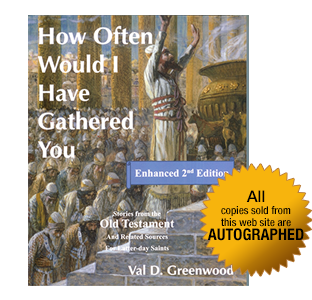Jeffrey Needle — A recent “B.C.” cartoon strip made its way across the internet recently. A worm is spitting out a dust ball and his friend, a pre-historic bird of some sort says, “Yuck! A dust ball! How disgusting.” The worm responds, “How can you treat a fellow creature with such disdain?” The bird answers, “I read the Old Testament, buddy.”
Indeed, it seems to some readers that the Old Testament is filled with all kinds of loathsome things — murder, incest, prostitution. Reading through this sacred testament can be something of a roller-coaster ride. Is there any redeeming value to reading the Old Testament? Perhaps the same might be said of the Book of Mormon. It, too, has a lot of warfare, a lot of death, a lot of sadness. But readers can sort through all of this and draw out so many important spiritual lessons.
Part of our appreciation of biblical history is an acknowledgement that along with the good there is the evil. Such things “must needs be.” The key to appreciating any sacred writing is in the ability to sort through the honest accounts and find that which is good, cling to it, and then be aware of the consequences of evil.
Over the years, scholars and teachers have come to recognize that studying the story line of the Old Testament is a valuable tool in understanding the work as a whole. One organization, “Walk through the Bible Ministries,” has designed an entire curriculum that allows the reader to skip portions of the Old Testament without missing parts of the overall story. For example, they would have you read Genesis, Exodus and Numbers, and have you skip Leviticus and Deuteronomy. Yes, you miss some of the teaching, but the story continues unabated by reading the books in this manner.
Our present book tries to accomplish this goal — learn the story of the Old Testament, but supplement this in a way that “Walk through the Bible Ministries” cannot: integrate the thoughts of LDS scholars over the years, the unique insights of Restoration scriptures, and the wisdom of generations of Mormon thinkers. The subtitle of the book explains it quite nicely: “Stories from the Old Testament and Related Sources for Latter-day Saints.” Greenwood has a goal — he wants you to see the wonderful continuity of the Old Testament story, the blessings of obedience and the challenges of faith. And, in my opinion, he accomplishes this nicely.
In a series of 229 brief studies, the author takes you through the story. His prose style is exceptionally easy; his grasp of the story solid. One can read each of the studies in just a few minutes. Each study is preceded by the scripture reference covered. Some of the studies are quite focused, covering just a few chapters of the scripture. Others are very broad — he covers the entire book of Deuteronomy in just one study! But this is as it should be — Deuteronomy does not move the story forward at all.
A nice selection of basic maps is included. Greenwood also includes a pronunciation guide to Old Testament words. A brief bibliography and both name and subject indices, close the volume. A word of caution about the indices – I neglected to read a note at the head of this appendix, notifying me that numeric references were to the studies, and not the page numbers! After looking up a few references incorrectly, I wondered how the author could have gotten it so wrong! Then I read the instruction, and was once again reminded of how important it is to read carefully!
Many of us have enjoyed jigsaw puzzles. We spill the pieces onto the table and then proceed to put them together according to the pattern on the box top. Imagine trying to assemble the pieces without having the picture on the box top! So many try to read the Old Testament piece by piece, without having the benefit of the big picture. This book gives you just that: the big picture.
“How Often Would I Have Gathered You” is not a scholarly tome, neither is it intended to be. Instead, it fills a gap between published Church curriculum and the larger, more detailed studies available to the interested reader. It reads like a novel, but it tells a true story. Readers of all ages will appreciate this resource and enjoy the fine work that Val Greenwood has provided for us.
The Old Testament: understand it, love it!



